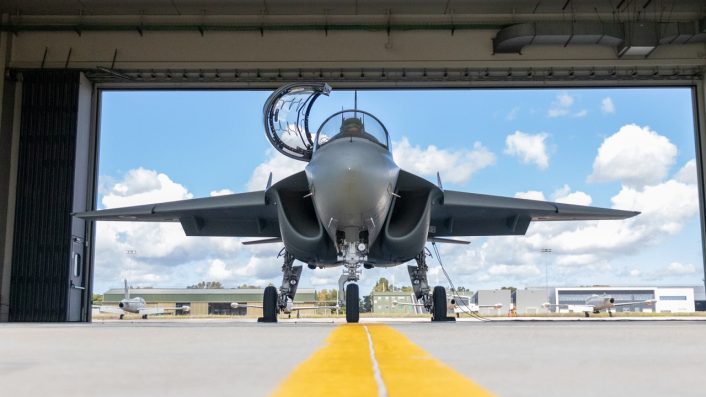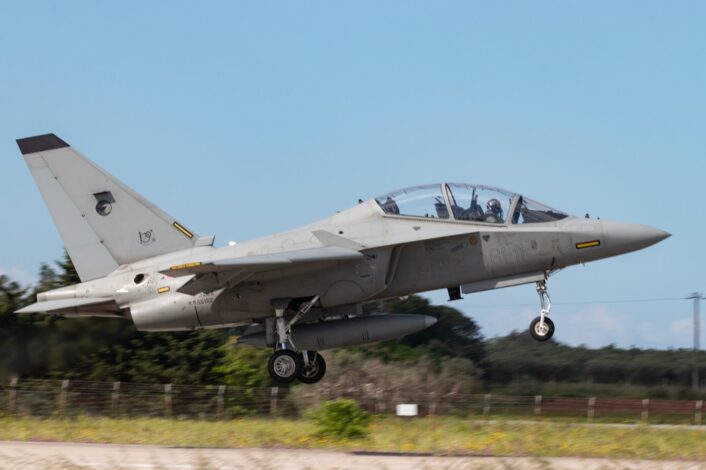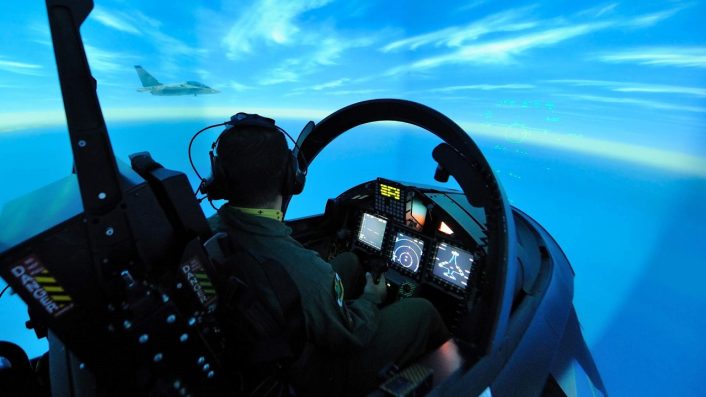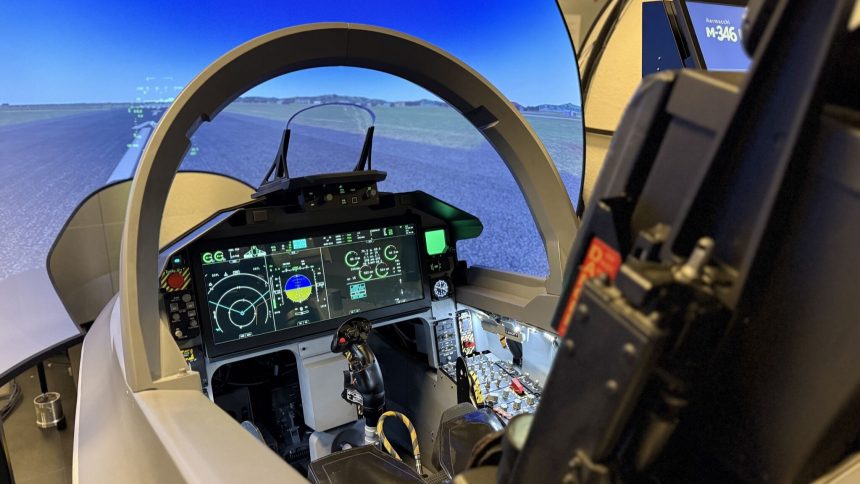The M-346 Block 20 will introduce an advanced Human-Machine Interface to replicate the operational environment of next-gen combat aircraft.
During the recent Military Flight Training Conference 2025, which took place in Italy from Mar. 31 to Apr. 2, 2025, Leonardo unveiled the new advanced cockpit designed for the new M-346 Block 20, which was announced last year. The new cockpit features an advanced Human-Machine Interface (HMI) with a Large Area Display (LAD), designed to replicate the operational environment of next-generation combat aircraft such as the F-35 and the future GCAP.
The new cockpit
Leonardo says the new cockpit significantly enhances the pilots’ situational awareness, reduces the cognitive workload, and supports an intuitive, high-fidelity training experience, ensuring a seamless transition to front-line platforms. As mentioned in recent studies about the Global Combat Air Programme (GCAP) in Italy and in the UK, military flight training must evolve to ensure maximum preparedness as the new aircraft is fielded.
Unveiled at #MFT2025: #Leonardo’s enhanced #M346 Block 20 cockpit sets a new standard in pilot training.
Featuring the Large Area Display, the new Human-Machine Interface (#HMI) mirrors the look and feel of next-gen fighters—boosting situational awareness, reducing workload,… pic.twitter.com/wpaM22EAWv
— Leonardo Aircraft (@LDO_Aircraft) March 31, 2025
In the new configuration, the cockpit will feature a 20×8 inches touchscreen Large Area Display (LAD), which replaces the three Multi-Function Displays (MFD) currently used, and a low profile Head-Up Display (HUD). This configuration, which is fully NVG-compatible, will be replicated for both the front and rear seats on both the trainer and fighter variants.
The aircraft will also be equipped with a Helmet Mounted Display (HMD), which reportedly has not been chosen yet. The M-346 is currently able to employ the Thales Scorpion HMD, and it is possible the same system or its improved Scorpion Hybrid Optical based Inertial Tracker (HObIT) variant will be included in the Block 20.
Leonardo says the new cockpit will be integrated into an M-346 Block 20 prototype by mid-2027, with the first aircraft delivery by the end of 2028. The first operator of the upgraded variant might possibly be Austria, which selected the M-346 last year, while Italy’s new M-346s will reportedly be in the current Block 10 configuration for fleet commonality.

The M-346 program and Block 20
On the occasion of the Military Flight Training Conference 2025, Leonardo also provided an update on the status of the M-346 program. Currently, 126 aircraft and 21 simulators have been sold and are used by 19 operators worldwide.
However, not all of them own the aircraft, as some of them use the Italian Air Force’s and Leonardo’s M-346 at the International Flight Training School (IFTS). Currently, Canada, UK, Germany, Japan, Austria, Saudi Arabia, Sweden, Netherlands, Hungary, Spain, Singapore and Qatar send their pilots to the IFTS, with Qatar also employing its own aircraft there.
Among the operators which own the aircraft, in addition to Italy and Leonardo, are Singapore, Israel, Poland, Greece, Qatar, Turkmenistan and Nigeria, while Austria has selected the aircraft but has not yet signed a contract. The fleet has flown over 130,000 hours globally.
Leonardo says that the Advanced Jet Training is facing a rapidly changing operational environment, because of the evolution of military requirements and the introduction of new technologies. The company says the M-346 is designed to be flexible and to constantly look at the future so training can be both cost-effective and sustainable.

The M-346 Integrated Training System is the backbone of the joint Leonardo-Italian Air Force IFTS, based on a complete, fully immersive system for an extensive training experience. Leonardo mentions among the key advantages the safety, the flexibility and adaptability, the efficiency, the realism and the cost effectiveness both for training and as a force multiplier for front-line aircraft.
The new Block 20 will integrate leading edge technologies on both the aircraft and the Ground-Based Training System (GBTS). The goal is a massive digitalization powered by Artificial Intelligence, Virtual and Augmented Reality, introducing a “Hybrid Training” while enhancing the M-346’s renowned Live Virtual Constructive (LVC) environment.
AR will also be introduced in the HMD, hinting at a new visual representation of the entities simulated by the LVC environment which are currently not seen by the pilot flying on the real aircraft, but can only be represented on instruments and sensors. Among the other systems introduced will be Performance-Based Navigation (PNB) and Link 16 datalink.
The M-346 Block 20 will also benefit from new navigation, weapon management, flight management system, IFF (Identification of Friend or Foe) transponder. Specifically for the M-346 F variant, further critical capability enhancements include an AESA (Active Electronically Scanned Array) radar featuring fire control radar capability, integration of new weapons for both air-to-air and air-to-ground roles in addition to a built-in missile datalink.

The M-346 Integrated Training System
As we often reported, the introduction into service of the T-346 revolutionized the training. The M-346 is not just an aircraft, but an integrated system associated with simulators and multiple training aids. It’s the ideal system to train future fighter pilots which are not only required to be good pilots, but they also need to manage the entire weapon system with all its sensors and weapons in scenarios which are getting more complex, less permissive and with plenty of threats.
The GBTS, a fundamental part of the training system, is one of the most complete ever produced, and is composed by the Computer Based Training and a network of simulators which comprises Simulation Based Training, Partial Task Trainer, Full Mission Simulator. The other ground devices are the Real Time Monitoring Station and the Mission Planning and Debriefing Station.
The GBTS allows pilots to learn formation flight, basic maneuvers, advanced combat tactics, both day and night, without the need to get wheels off the ground. This allows a reduction of the flight hours required to compete the training of future fighter pilots of the latest generation aircraft, lowering the costs and improving the efficiency and availability of the fleet for operational tasks.

While the cost reduction is important, the M-346 ITS is unique because it allows the creation of the Live Virtual Constructive environment, an integrated training environment where the real and virtual worlds merge into a single operational scenario in which pilots in the simulators can interact with pilots flying on the real aircraft. This way, future Eurofighter and F-35 pilots can operate simultaneously real flights (live), simulators (virtual), and add at the same time different types of computer-generated threats (Constructive).
The T-346s also have an integrated onboard Embedded Tactical Training System (ETTS), which allows the simulation of sensors, weapons, simulated forces so that pilots can interact in real time with a tactical virtual scenery. Among these, we find advanced simulations of radar, datalinks, targeting pods and all kind of sensors used on modern fighters.
The M-346 has an advanced aerodynamics with high thrust-to-weight ratio and supersonic speed which, coupled with fly-by-wire controls and modern and efficient turbofan engines, makes it a trainer with high performances and high maneuver energy, that put the aircraft on a completely different level compared to other trainers. Thanks to its performance and capabilities, the T-346 is considered on the same level of the F-16 Fighting Falcon.
All these capabilities allow the pilots to develop all the skills they need before moving to the Operational Conversion Units. The aircraft’s performances have been further expanded recently, with the increase of the maximum allowed angle of attack from 25° to 30° and the increase of the G limit when the aircraft is equipped with a centerline external fuel tank from 5 G to 6 G.









